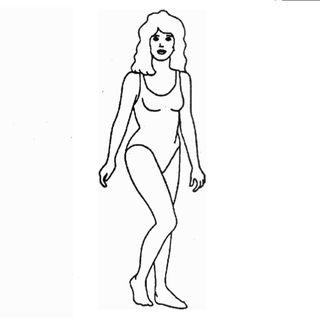Health
The Hourglass Figure Is Not a Sign of Fertility and Health
There's a different reason men find low waist-to-hip ratios attractive.
Posted June 17, 2019 Reviewed by Hara Estroff Marano
I have attended a number of conferences over the last four decades, and I have been impressed by many talks I’ve heard. I have often returned home inspired not only by how much we had learned about human nature but also humbled by how much there was to learn.
I recently attended the 31st annual meetings of the Human Behavior and Evolution Society (HBES). Over the years, attendees at this conference have included some of the most brilliant people on the planet (including E.O. Wilson, Richard Dawkins, Leda Cosmides, Sarah Hrdy, Steven Pinker, and Napoleon Chagnon).
The HBES meetings have always been especially impressive, and the conference last week once again showed just how much I have to learn.
When it's good to find out you're wrong
There is a particularly troubling misconception about science, and it is one that has continued to be advanced even by highly educated academics, including many professors in the humanities and social sciences. That misconception is that scientific beliefs are a simple matter of individual choice and personal taste. On that view, there is no such thing as scientific progress, only a historically arbitrary sequence of paradigm shifts, or changes in what it’s hip to believe today.
But in fact, the hallmark of a scientific approach is the attempt to use rigorous methods to discipline our biases, to overcome our particular preferences about how reality should be, and to force us to objectively consider evidence that reality might, in fact, be a bit different than we were wont to believe.
It is not that scientists are not prone to all the same biases and preferences as everyone else, but if they are doing their job properly, they find ways to force themselves to objectively consider the evidence for or against those biases and preferences. (see the Science of Antiscientific Thinking)
So, it should be particularly satisfying for a scientist to change his or her mind in the face of evidence. But because of all our strong biases, the new evidence has to be solid and convincing.
Thus, I was delighted when I heard UCSB anthropologists Steve Gaulin and William Lassek give a plenary address that actually changed my mind about something I had previously believed.

Here’s what I believed: “Women with relatively low waist-to-hip ratios (around .7) tend to be healthier and more fertile, and to have healthier children.”
I believed that so strongly that I actually said those exact words in my social psychology textbook (Kenrick, Neuberg, Cialdini, & Lundberg-Kenrick, 2019). And I was not alone in believing this, in fact, it was the explanation offered by Dev Singh, who pioneered in demonstrating that men are strongly attracted to women with relatively low waist-to-hip ratios.
But Gaulin and Lassek’s talk presented evidence that led me to completely change my mind. And then they made it easier to swallow by presenting evidence that strongly suggested another adaptive reason for men’s strong preference for women with hourglass figures (aka a .7 waist to hip ratio).
So, what’s going on? According to the evidence presented by Gaulin and Lassek, and published in a pair of recent articles in the journal Evolutionary Psychology, it is actually healthier for a woman to carry a little extra body fat, even when that fat is stored on her midsection. Furthermore, women with a bit more overall body fat are actually more fertile (Lassek & Gaulin, 2018a; 2018b).
If not health and fertility, what makes a low waist-to-hip ratio attractive?
Is men’s attraction to women with narrow waists simply maladaptive then? No. According to Gaulin and Lassen, narrow waists relative to hips are a signal of mature youth (that distribution of fat is found in women in their early teens; younger girls have narrower hips relative to their waists; older women have wider hips, but also more fat deposited on the waist, especially after they have borne children). Once a girl reaches puberty, she begins to distribute a particular type of fat on her hips and thighs – omega 3 fatty acids. That fat is especially important for her potential offspring's brain development.
The hourglass figure is a signal not that a young woman is now maximally fertile, but that she has not yet had children, and is likely to give birth to healthy children with large healthy brains. In traditional societies, those births are likely to occur almost a decade after the age of the most attractive waist-to-hip ratios.
So, a young woman with .7 waist-to-hip is not so much fertile as nubile (in the sense of having reached puberty, but not yet having borne any children).
The fact that men are inclined to choose women with that particular body shape, Gaulin and Lassen argue, is an indication that our male ancestors were in it for the long run. If they were only seeking partners for the short-term, they would choose slightly older partners with a bit more body fat, who were likely to be maximally fertile over the next few months. Instead, men’s preferences indicate that they are choosing partners who have reached puberty, but who have a maximum number of remaining reproductive years.
Related blogs on youth and the biology of attractiveness
- The mind as a coloring book. A discussion of the universal attraction between older men and younger women, and some apparent cross-cultural exceptions.
- The mind as a coloring book 2: An explanation of why the young men in Tiwi society all marry older women, and why it's not evidence of a Blank Slate mind.
- Sex, lies, and big data. How do clicks on OK Cupid reflect on the universal attraction between older men and younger women?
- Does ovulation change women's sexual desire, after all? Reports on another interesting thing I learned at the recent meetings of the Human Behavior and Evolution Society.
- Why are Hollywood actors paired with such young women?
- A link between a prostitute's age and her income.
- Older men, younger women, and the psychology of rejection.
References
Kenrick, D.T., Neuberg, S.L., Cialdini, R.B., & Lundberg-Kenrick, D.E. (2019). Social psychology: Goals in interaction 7th edition. Boston: Pearson
Lassek, W. D., & Gaulin, S. J. (2018a). Do the Low WHRs and BMIs Judged Most Attractive Indicate Higher Fertility? Evolutionary Psychology, 16(4), 1474704918800063.
Lassek, W. D., & Gaulin, S. J. (2018b). Do the Low WHRs and BMIs Judged Most Attractive Indicate Better Health? Evolutionary Psychology, 16(4), 1474704918803998.
Singh, D. (1993). Adaptive significance of female physical attractiveness: Role of waist-to-hip ratio. Journal of Personality & Social Psychology, 66, 298.




